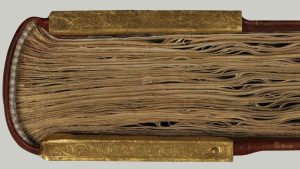2 There’s no “DIN”-format in Early Modern Times: Paper formats
2.1 How a book is made
The first thing that strikes the eye, at least subconsciously, when you pick up a book - whether printed or handwritten - is its size. Nowadays, we have several standardised paper formats. Until the 20th century, however, people experimented with different formats, so that over time a multitude of paper sizes developed, which made standardisation necessary in the first place.
The paper made in paper mills in Early Modern times could differ in size, even though most mills worked with a paper sieve of approximately 30x42cm. In addition, books had to be trimmed at the sides after binding, whereby the final size could again change slightly. Apart from the exact size, which can be found today in the catalogues (online or printed) of the holding institutions and, sometimes, in databases such the Répertoire International de Sources Musicales (RISM), the VDM16 and the VD16, the formats of Early Modern books are often referred to as, for example, 2° (Folio), 4° (Quarto) or 8° (Octavo).
The names of the formats result from the process used to make a book: A book consists of multiple layers (you can imagine them as thin ‘booklets’) bound together into a ‘book block’. The binding with a more or less splendid cover is a step that was often not carried out directly in the print shop, but only after the book had been purchased – depending on the buyer and the purpose for which he bought it. For specific questions (e.g. if you’re interested in the origin and age of the paper itself witch can be detected using the watermarks), it might be useful to decipher the exact order of the layers. Most printers do us the favor to indicate the layering with small letters and numbers in the corner of the recto pages.
 Detail: book block of a choirbook manuscript. It is possible to detect the separate 'booklets' bound together.
Detail: book block of a choirbook manuscript. It is possible to detect the separate 'booklets' bound together.
Cipriano de Rore, Motets, Munich, 1559.
Munich, Bavarian State Library, Mus.ms. B(1.
Click here to access the full digitized source.
 "A 3" (bottom right corner) indicating that it's the third sheet ("3) of the first layer ("A").
"A 3" (bottom right corner) indicating that it's the third sheet ("3) of the first layer ("A").
Leonhard Lechner, Liber missarum sex et quinque vocum, Nuremberg (Katharina Gerlach), 1584.
Munich, Bavarian State Library, 4 Mus.pr. 94#Beibd. 10, Tenor fol. 3r.
Click here to access the full digitized source.
The individual layers are created from the original sheet of paper (bought at a paper mill), which is folded one or more times and then cut open on three sides. The formats result from how often the sheet of paper was folded for this purpose: A single fold leads to a rather large Format, the Folio (2°, resulting in 4 pages per paper sheet), two folds (transversely and longitudinally) to a Quarto (4°, 8 pages), four folds (the quarto folded transversely and longitudinally once again) to an Octavo (8°, 16 pages).
 Paper foldings - the dotted lines indicate the size of the formats relative to the full sheet.
Paper foldings - the dotted lines indicate the size of the formats relative to the full sheet.
While these three formats are the most common ones (and thus, the ones one should really know), there are even more variants of folding the paper, leading to different formats such as the Sestodecimo (16°, or: an Octavo folded once again, leading to 32 pages and a pretty small book). Furthermore, the paper sheets might be sewn together without folding them first - this huge format, often used for more splendid books, is also called Folio.

Book formats/sizes compared (true to scale).
Click here to access the fully digitized 2° choirbook 2 Mus.pr. 20.
Click here to access the fully digitized 4° partbook set 4 Mus.pr. 142.
Click here to access the fully digitized 8° partbook set Mus.pr. 9744.
Each variant can be used either as portrait format or as oblong format (whereby the Folio appears almost exclusively in portrait format)– when describing sources, this information is often given as a supplement to the simple indication 2°/4°/8° etc.
Just like modern libraries, also Early Modern bibliophiles were aware of the format, as can be seen from the frequent format indications in fair- and library catalogues (for example the catalogues of the books at the Frankfurt fair by Georg Willer, a booktrader from Augsburg). Sometimes it was even used to structure the collection (or the catalogue).
With any type of printed product, the format can provide valuable information about what purpose or clientele it was intended for. Large formats (especially Folios) tend to indicate that they are representative books - similar to coffee-table books - while smaller formats are more likely to be pocket reading. In the context of music printing, there is an additional aspect regarding the choice of format, which will be dealt with in the next chapter.